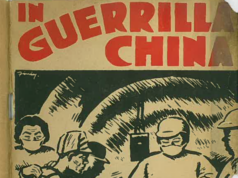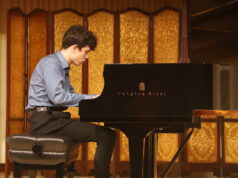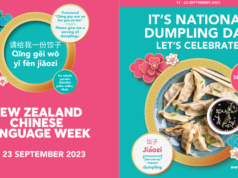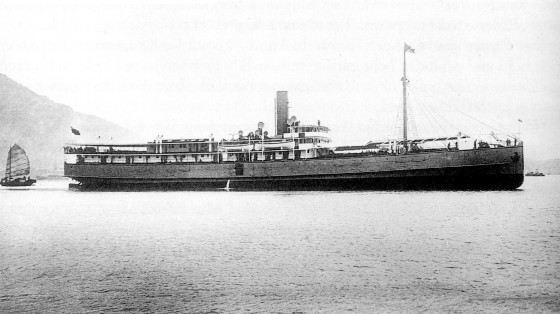
The following is an eyewitness account of Japanese attacks on British ships which were evacuating British and Chinese company personnel as well as several diplomatic personnel from Nanjing as Japanese forces were approaching Nanjing in 1937.
The log was written by William G. McKenzie, the Master of SS Whangpu. Harold Boyack, First Mate on Whangpu was uncle of John Hodgson, the president of the New Zealand China Friendship Society’s Tauranga Branch, who kindly provided the story.
It is poignant to note that the account records what was happening on the Yangtze just before and during the ‘Nanking Massacre‘ following the occupation of Nanking [Nanjing] by the Japanese army December 13, 1937.
Background:
The Second Sino-Japanese War had started July 7, 1937, with the Marco Polo Bridge Incident in Beijing, and, after the encircling of Shanghai started in August, Shanghai fell to the Japanese forces on November 12, 1937. Then the Japanese advanced westwards, chasing the Chinese troops through Suzhou, Wuxi, Changzhou and Zhenjiang, towards the Chinese capital, Nanjing. They were reported to be committing atrocities as they advanced.
After the fall of Shanghai, the Chinese government announced, on November 20th, that it would move its capital from Nanjing to Chongqing in Western China, with some Ministries, including Communication and Finance, first relocated to Hangkou. United States, Great Britain, France, Germany, Russia, while urging their citizens to evacuate Nanjing, relocated their embassies: the British first to Hankou (3 December) and then to Shanghai (December 9), leaving a skeleton consulate in Nanjing.
However, the Japanese Consul advised that all foreign nationals remaining in Nanjing should “stay away from the fighting by evacuating that city without delay”. On December 8, as the Ambassador Knatchbull-Hugessen was in hospital having been wounded (August 26) – in an attack by 2 Japanese war planes on his car displaying Union Jack, British Consul Prideaux-Brune, who was in charge of the British Embassy, decided that all British nationals remaining in Nanjing should evacuate to the ships on the Yangtze River near Xinguan (on the left bank facing Nanjing).
SS Whangpu with Lighter 13 in tow, had been standing by at Nanjing as a relief ship and in case she was required below any possible boom between Nanjing and Hankou (emplaced by the Chinese to limit upstream access by Japanese vessels).
Note that SS Whangpu was one of 60 ships run by Butterfeld & Squire‘s China Navigation Company mainly on the Yangtze and China’s East coast. See end notes for details of the ships involved, including owners and limited list of the passengers. It is perhaps interesting to note that Britain was neutral in the Sino-Japanese War, until 1943.
During the period covered by account below, “fires were burning all around Nanjing, as the Chinese were burning all possible cover for Japanese troops outside the city walls. Shell fire was continuous and during the day there were frequent air raids on Pukow and Nanking city” [from ‘A Dark Page in History’, see reference below].
Extracts from the official log book of S.S. Whangpu:
CONCERNING THE SHELLING AND BOMBING OF HER BY JAPANESE FIELD GUNS AND BOMBING PLANES ON THE 11th AND 12th OF DECEMBER 1937
At 10th Dec 1937, Mr. A. Orr, 2nd Engineer, was this day transferred to the Company’s M.V. “Tantung” being appointed Chief Eng. in place of Mr. Morice, whom I shipped as passenger to Shanghai owing to his bad condition of health and also wounds received by metal (shrapnel) from Japanese bombs when “Tantung” was murderously bombed by Jap air bombers. “Tantung” meantime beached in a sinking condition.
“Whangpu” proceeded to Nanking [Nanjing] this evening at five. She is to go to Shanghai eventually when the Kiang yin [Jiangyin] Barrier is pierced by the Japanese Naval Forces. The ship carried absolutely no cargo, being merely a refugee ship carrying about three hundred refugees, mostly Chinese woman and children. “Whangpu” anchored at the recognised “Safe Anchorage” three miles above Nanking at nine pm same day. Wuhu City was in flames when we left there.
AT NANKING – SHELLING OF “WHANGPU”
11th. Dec 1937 Weather fine and clear with all British ships well anchored in the OFFICALLY RECOGNIZED SAFE ANCHORAGE, accompanied H.M. Ships Cricket & Scarab, also “Tien Kwang” “Wantung” “Tseang Tah” and other vessels.
1420 to 1536: At 1420, heavy shells from shore batteries on left bank began to scream close overhead causing the ship to shudder violently with the concussions. As we were anchored in the so-called safety zone we anticipated no danger but when the shells began to plough the water a mere few hundred feet away, I ordered steam on the main engine in the shortest possible time. The extreme urgency of the case forced us away in the remarkably short period of seven minutes.
The Company’s “Wantung” steamed speedily by us pursued closely by heavy shells. As soon as the “Whangpu” got under way all the shelling was diverted to us and soon began to fall perilously close by, causing huge spouts of water close ahead and on our port beam. Some of the shells shrieking very close over our bridge.
I changed the ship’s head as often as possible, zigzagging in order to confuse the gunners. Every ounce of steam was rung for urgency. Having a 350 [ton] lighter full of wood oil alongside us rather handicapped our mobility. Only for the danger into which I would have to put the other ships which were racing along close astern of us I would have abandoned the lighter. However, despite the drag of the lighter, the “Whangpu” sped ahead of the column of fleeing ships and being by far the largest of the fleet present all the gun fire was concentrated upon us. We bore the brunt of the murderous firing. This fortunately helped all the other ships in that we purposely drew the fire away from them.
After racing up stream amidst the huge columns of water created by the shells, we eventually anchored at Rosina Beacon – 14.5 miles [23.3 km] above Nanking. It took over one hour to outdistance the range of the guns. During this period we counted nineteen shells. Our escape from destruction can be attributed to the prompt and efficient manner in which the Chief Engineer got up and maintained a high pressure of steam.
During this deliberate and murderous bombardment all the passengers were ordered to remain below the decks. Fortunately no person was hurt. Some of these shells missed us by less than twenty feet. They fell so close that we were actually steaming over the boiling mass of water left by the shell on landing. Many heavy pieces of shrapnel were collected from the bridge and upper decks after we anchored. Lifeboats and tanks were pierced by shrapnel.
At 1440 I anchored in midstream in 5.5 fathoms [10.1 metres] of water off Rosina Beacon – 14.5 miles above Nanking where I anchored the oil lighter.
This reach was selected by me owing to its great breadth – making it fairly safe against snipers from the banks, and for its shallow water, in case we were sunk by further attacks.
At 1940 we returned to relieve H.M.S. Scarab of Jardine’s Hulk which he had rescued from the “safe Anchorage” during the bombardment. At 2358 we anchored near the oil lighter off Rosina Beacon with the Hulk alongside us.
All the other British Ships followed up and concentrated in this locality, including H.M. Ships Cricket and Scarab.
During this bombardment we had on board the British and German Embassies also the Military Attaché Colonel Lovat Fraser. They boarded us from Jardine’s Hulk (acting refugee depot) a few hours prior to the shelling. A vigorous protest was immediately radioed from the British and German Embassies.
THE BOMBING OF “WHANGPU”
14.5 miles [23.3 km] above Nanking 12th. Dec 1937.
Weather was fine and clear with a cloudless sky. At 1320 three Japanese Bombing Planes observed to be approaching from the South eastward at a height of about three thousand feet. The brilliant sunshine glistened on their silvery colour. Suddenly to my consternation they zoomed suddenly directly towards “Whangpu” in line ahead formation.
At 500 feet they released one bomb each upon us, all of which fell only about twenty to fifty feet away from us causing terrific concussions throughout the ship shattering windows and doors. All persons were ordered by me to lie face down flat.
The Chief Officer and myself rushed down below decks to see the Chinese passengers – mostly woman and children – scenes of indescribable confusion met us. Hundreds were stampeding and shrieking madly. The sight was ghastly and pitiful. After passing over our ship (with the Jardine hulk still along side us) the bomber returned to the attack. They again power dived towards us with a sickening roar. Bombs were again released upon us after the first bomb of the second raid fell very close to us. H.M.S. Cricket and Scarab opened fire with Lewis and also 3” [100mm] guns upon the Japs.
The defence given by the gunboats prevented the planes from diving so close to us and definitely was the means of preventing the Japs from completing their murderous task. These despicable Japs obviously meant to wipe us out. The outrage was directed towards the “Whangpu” and the Jardine’s Hulk alongside of her. Two more bombs were dropped very close to us again causing terrific concussions throughout the ship. Six bombs were rained upon us during the raid, the last two of which wrecked our smoke room. About one dozen of the foreign passengers were in the smoke room. About one dozen of the foreign passengers were in the smoke room just prior to tiffin (a light meal especially lunch) and if the raid had happened at this time most of them would have been cut to ribbons with flying plate glass. We would have suffered many deaths. Immediately after this terrible outrage I ordered steam on the main engines and in order to become mobile and also to spread out from the other ships. Before changing our position all foreign passengers with the sole exception of Mr. Williams of the British embassy were transferred to H.M.S. Cricket from “Whangpu” as obviously the Japs had marked out “Whangpu” for total destruction – their persistent attacks proved this.
At 1605 “Whangpu” with the Jardine’s Hulk alongside whilst manoeuvring suddenly observed three Jap bombers approaching from the same direction as before, whereupon I manoeuvred “Whangpu” to the position of greatest advantage for protection from H.M.S. Cricket – four points abaft his beam, distant about one cable. The three Jap bombers again power dived directly at us and dropped four bombs close to us, one of which fortunately was a dud. Immediately the bombers came within range of the 3” [76mm] and Lewis guns of H.M.S. Scarab and Cricket they opened very effective fire upon them. The excellent gunnery forced the bombers away. They did not return to the attack. They could not face the guns. All they understood was the mass murder of innocent and defenceless people. During the second raid the Chief Officer, one Quartermaster and myself were on the bridge maintaining our position off the Cricket determined to be the cause of giving the murderous Japs as much gunfire as possible. All others were under cover. In the engine room the Chief and others were nearly blinded with ash and coal dust caused by the enormous explosions so close alongside the ship. The Chief Officer displayed great courage. (Capt. Harold Boyack). Every order given to him was carried out promptly and efficiently, and with no confusion. He was a good example to others.
When this disgusting raid was over I decided to abandon the Jardine’s Hulk. I anchored it in 4.5 fathoms [8.2 m], then cast off from it. Being together we presented a large and temping target for the Jap bombers. When this was completed I anchored half a mile ahead of the H.M.S. Scarab for protection as directed by the SNO [Senior Naval Officer] present. Only for the grand defence afforded us by the Royal Navy “Whangpu” would certainly have been wiped out with a great loss of life. There would have been an appalling loss of life.
It should be pointed out that eight large motor boats full of fully armed Jap soldiers complete with many machine guns rounded the “Whangpu” on their way down stream. After cautiously approaching us they gave us scrutiny on both sides. They appeared to be quite satisfied that we were certainly neutral so continued on their way. One of the soldiers pointed towards the sky at the chief engineer – motioning upwards with his pointed finger. Afterwards we realized the significance of this motion; meaning I presume, “Up you will go”
NOTE: THIS PARAGRAPH (above) DOES NOT APPEAR IN THE OFFICAL LOG BOOK.
After a conference on board H.M.S.Cricket it was decided to immediately berth both the “Whangpu” and the “Wantung” close alongside the north bank of the river half a mile apart and each to utilize a lighter to facilitate landing, in order to temporarily disperse the terrified passengers and all the members of the of our crew over a wide area of the country side. As soon as we berthed all our passengers (Chinese) made a wild dash to the fields for safety. Shrieking and moaning in a demented state they fled, leaving most of their gear in panic. Some members of the crew joined the mad rush from the ship. We made all efforts to reassure them but nothing could stem the frenzied exit. Most of them were demented as a result of the terrible bombing, some were stupefied or stunned.
That evening Officers and the remainder of the crew slept on board with orders to leave the ship entirely deserted before dawn as I considered it senseless to sacrifice lives convinced that the Japs would complete the destruction of the “Whangpu” on the following day, and should such happen no lives would then be lost.
At 1940hrs (same day 12th) we hove up anchor and proceeded to pick up lighter No 13. at 2200 the ship was safely berthed alongside of the left bank of the river lying against soft mud with 80 fm.[146 m] of cable on Port anchor leading six points on the port bow & with 45 fm. [82 m] of cable on the Starboard anchor, leading ahead. The officers and crew were this evening given definite instructions in preparation for at least one day in the fields, from where we would watch over the ship.
Next morning (13th) at 0250 a large junk floated down very close to us. Burning furiously with a large cargo of kerosene or spirits, its white heat created a great heat as it as it passed down. All hands were mustered to fire stations. It cleared us at 0315.
On the 13th at 0600 all remaining hands go ashore and disperse in the fields as directed by the Master, being advised not to go any further away than ¼ of a mile [400 m]. The absolute necessity of keeping in small detached groups was emphasised by me. All hands had sufficient water and food for at least three days, and ample spare clothes, including blankets.
At 0830 the Master, the Chief engineer and Chief Officer (Harold) returned to the ship to disperse looters who were hurriedly stealing passengers’ luggage. Armed with revolver and much ammunition, we shot them away. Others ashore were rounded up with gunfire and suitably dealt with. After this affair we changed our position ashore in order to better guard the ship. We took possession of all territory within the radius of ½ of a mile [805 m] from the ship, guarding same with revolvers throughout the day.
On five occasions during the day we had to cower in the mud to evade being spotted by Jap planes which hovered overhead very close each time. This precaution was necessary to prevent being drilled with Jap machine-gun bullets from these same planes. They obviously did not like us……and we were certainly not trusting friends.
At 1730 all hands ashore returned to the ship. A general muster disclosed that many had deserted the ship but we had sufficient left to maintain mobility. We slept on board that night. I returned from on board H.M.S. Cricket that evening at 11:30. It was then generally accepted that the danger had passed owing to the offices of the Rear Admiral Holt at Wuhu, also London and Tokio [Tokyo].
On the 14th, we re-embarked with only about …. [Editor’s note: number is missing in the available copy] passengers. Only this small number responded to our repeated blasts on the steam siren. H.M.S Cricket sent a repair squad to render assistance in making the foreign passenger accommodation serviceable, also temporary repairs to the bridge and smokeroom. At 1430 we hailed away from the bank and proceeded along side of Jardine’s Hulk again in order to move same up the following day to a better anchorage. Foreign passengers were transferred from H.M.S.Cricket to “Whangpu.”
During the two bombardments from the Jap air bombers on the 12th. inst., we had on board, among other passengers, members of the British and German embassies besides other foreign woman and men, also refugee children – 25 foreigners in all. Besides these, we had more than 350 Chinese men and women (refugees) in the Chinese accommodation, also hundreds of Chinese male passengers, making a total of not less than 800 excluding the crew. This number included the refugees from Jardine’s Hulk who scrambled aboard “Whangpu” after the first bomb had dropped….NONE OF THESE WERE CHARGED ANY FARE, food only to be paid for. They were refugees driven from their homes by war.
NATIONAL COLOURS AS DISPLAYED BY THE “WHANGPU” DURING THE SHELLING AND BOMBING
ON THE FORE DECK:- One Union Jack brilliantly painted on a tarpaulin which was (& still is) spread over the forward awning. SIZE: 36 x 24 ft. (thirty six by twenty four feet = 11m by 7.3m).
ON THE SUN DECK:- Two Union Jacks painted in brilliant colours on the wood deck – one on each side near aft. SIZE (each): 15’ by 10’ (fifteen by ten feet = 4.5m by 3m.)
ON SHIP’S SIDE:- One on each side of the ship just forward of the bridge, brilliantly painted: SIZE (each) 15x 8’ (fifteen by eight feet = 4.5m by 2.4m).
Besides these distinguishing marks, we had the ship’s name painted on the foreward truck [= a wooden disk on top of the mast], also a pilot jack on the Jackstaff [=short flagpole on ship’s bow]. All these flags were new and were kept flying night and day during the 11th 12th 13th 14th 15th 16th & the 17th – day of arrival in Shanghai.
15th. at 1330 Anchored Jardines Hulk and cast off same.
15th. (same day) at 1500, the “Whangpu” joined the Naval Convoy, taking position four in the line with the loaded lighter No 13 in tow alongside. One Japanese destroyer took the lead and another the rear with U.S.S. Oahu in position two , H.M.S. Ladybird in position three and the “Wantung” in position five just astern of us. All ships proceeded at half mast as the U.S.S. Oaho and the H.M.S. Ladybird were conveying the bodies of the men killed by Jap bombers (U.S.S Panay) on the 12th inst. about ten miles above our position when attacked, and killed by gunfire from Jap shore batteries at Wuhu on the same day [The Panay Incident].
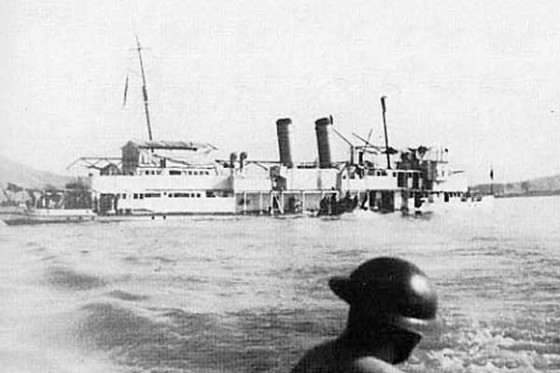
1615 Anchored for the night about five miles above Nanking.
Approaching this anchorage, a raft with three Chinese peasants was seen to be paddling towards Nanking. These men were oblivious, entirely ignorant of the fact that Nanking was at the moment in flames. Three Jap patrol motorboats then appeared running upstream, each fully ladened [sic] with armed soldiers. They spotted the raft, altered course towards it then the first one ran over the raft, the second one ran over the men floundering in the water, and the third one shot at them although they were already more dead than alive. There was no challenge, it was direct and deliberate murder. Much to their annoyance H.M.S. Ladybird dropped a boat and rescued the men. After anchoring, the Jap destroyer cautioned them by Morse against repetition. This discourteous behaviour was ignored by the Ladybird.
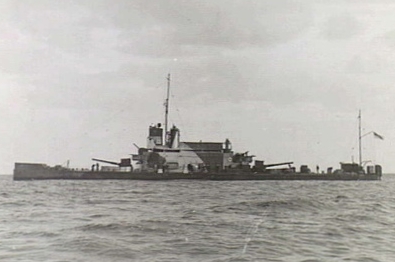
During this night bombs thudded incessantly, and shell shrieked away making things miserable for an already thoroughly nervous group of passengers. None slept well that night.
Dec 16th at 0655, the trip was resumed, each ship taking its former position in the convoy. Speed ten knts [knots] = 18km/h. Draft limit to 9.5 ft [2.9m].
Dec 16th at 1620, all ships anchored for the night four miles above Kiang Yin [Jiangyin] Forts.
Dec 17th at 0612, the convoy continues towards Shanghai in the same formation. Many sunken ships were seen at the formidable Barrier near Kiang Yin Forts. Japanese destroyers lead the ships, operating paravanes for the clearance of mines in the channel. This same day at 1715 “Whangpu” made fast to Pootung [Pudong] Wharf (Shanghai).
DAMAGE TO “WHANGPU”: (Superstructure) Superficial damage to all foreign passenger accommodation, particularly the smokeroom which was badly shattered. No. 2 lifeboat holes. Bridge and Master’s room windows badly shattered, also woodwork blown in. Chinese second class rooms smashed up.
SUSPECT DAMAGE TO HULL, especially aft at No. 3 Cargo port (distorted).
Strong room distorted.
Many pieces of shrapnel found on upper decks and on the bridge.
BY SHELLING. Sanitary tank on the upper deck holed. Nos. 2 & 4 lifeboats holed. Many pieces of shrapnel found on the main and upper decks, also bridge.
THE FOLLOWING MEMBERS FAILED TO RETURN TO THE SHIP
No. 6 – 3rd. Engineer
“ 22 – Carpenter
“ 41 – Fitter
“ 43 – No 2 Fireman
“ 44 – No 3 Fireman
“ 46 – Trimmer.
“ 47 – Trimmer.
“ 61 – Steward.
“ 62 – Ship’s Cook
“ 63 – 2nd Cook.
“ 64 – Saloon Boy.
“ 69 – Messroom Boy
Owing to the ghastly experience these men have been through during the deliberate and murderous attacks from first the heavy Japanese field guns on the 11th. inst. then the Japanese bombs from the air on the following day, I urge they be treated very leniently for most likely some of them have become temporarily mentally deranged.
Amongst these No 22 (Carpenter) behaved quite well during the crisis considering the terrible conditions.
SIGNED BY:-
W.G. McKenzie (Master ) Harold Boyack (First Mate)
24th. Dec, 1937
COPY Edited by Duncan and Teri France ([email protected])
___________________________________________________
Further reading: Shanghai 1937: Stalingrad on the Yangtze, Peter Harmsen, 2013 (Hardback), 2015 (Paperback). ISBN: 978-16-1200-1678
A Dark Page in History: The Nanjing Massacre and Post-Massacre Social Conditions Recorded in British Diplomatic Dispatches, Admiralty Documents and U.S. Intelligence Reports, Edited with introduction by Suping Lu, 2012. University Press of America, inc. ISBN: 978-0-7618-6552.


